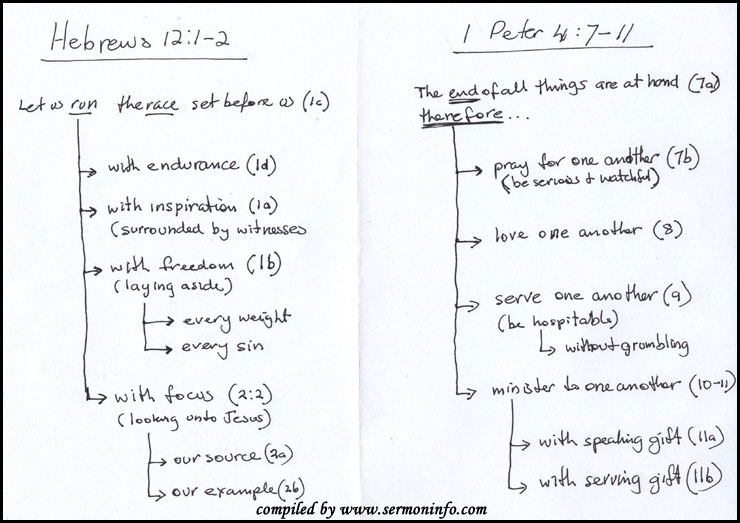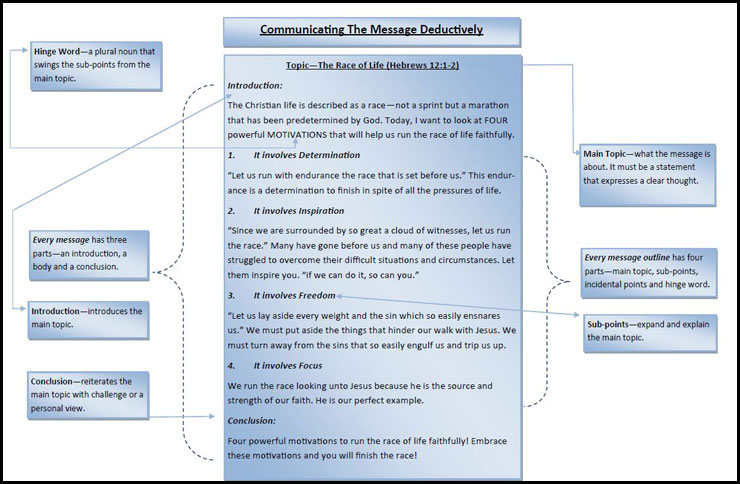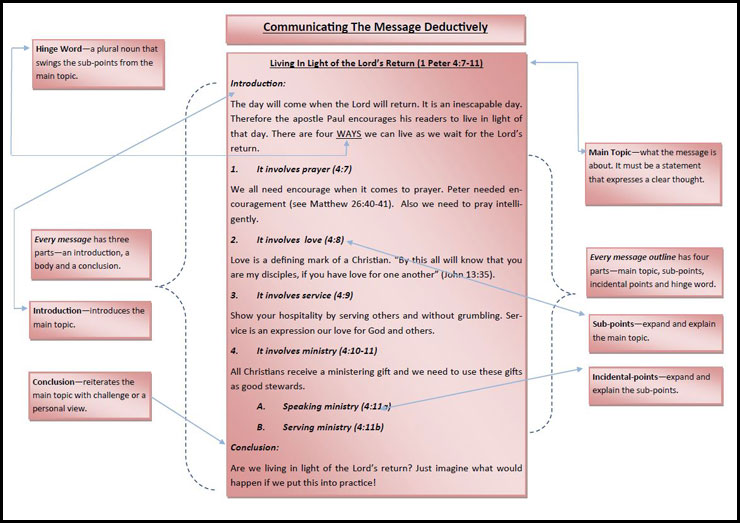How To Write A Sermon For Beginners: I have been writing weekly sermons for nearly thirty years or so and I have learned much in that time about writing sermons.
Students often ask me for tips for writing sermons for beginners. I remind them that good sermons are never accidents and I usually share with them the following five tips that will help them prepare a sermon for their audience.

How To Write A Sermon For Beginners
I have never found sermon writing easy. It is hard work writing weekly sermons year by year. However, it does get easier and enjoyable if you consider the following five tips below.
1. Find a Familiar Scripture
I always encourage students to start with a familiar verse or passage of Scripture. This will help your confidence in writing a sermon and presenting that sermon to your audience.
If you are beginning a weekly preaching ministry, I would encourage you to preach through a book of the Bible. It needs to be a book that you know very well like Ephesians, Colossians or Philippians.
When I started my preaching ministry, I preached through the book of Ephesians because I had done all the hard work in my Greek class – diagrammatical outline and exegetical outline with a running commentary of the book. You could say that I knew the book and its content well.
2. Study the Selected Scriptures
The study process involves reading, observing and interpreting the text of Scripture you have selected to preach. Howard Hendricks provides an excellent overview of this process in his book, Living by the Book (Check it out at Amazon).
In the study process, I encourage students first of all to draw a the mechanical layout of the text or passage of Scripture. The mechanical layout (also known as block diagramming) will help students observe the relationships between the main and subordinate ideas presented in the Scriptures.
It is noteworthy to remember that good sermons are never accidents. They generally come as a result of hard work. The mechanical layout takes time but the results are definitely worth it.
I found that this process of sketching a mechanical layout of the text to be a defining moment in my development in sermon preparation.
Let me give you a couple of examples. The first example is from Hebrews 12:1-2 and the second example is from 1 Peter 4:7-11.

The primary task of the mechanical layout of the Scriptures is to help you discover the main and subordinate ideas and how they relate to each other.
In Hebrews 12:1-2, we discover that the main idea is: running the race of life faithfully. The subordinate ideas are: with endurance, with inspiration (surrounding by a cloud of witnesses), with freedom (laying aside every weight and the sin which so easily ensnares us) and with focus (looking unto Jesus).
In 1 Peter 4:7-11, we discover the main idea is: living in light of Jesus’ return (the end is near). The subordinate ideas are: pray for one another (be serious and watchful in your prayers), love one another (have fervent love for one another), serve one another (be hospitable to one another) and minister to one another (as each one has received a gift, minister it to one another).
Robertson McQuilkin provides an overview of the process of the mechanical layout in his book, Understanding and Applying the Bible (Check it out at Amazon).
If you are seeking to be a seasoned preacher, you will need to master the skill of sketching a mechanical layout of the Scriptures because it will help you see the main actions and subordinate actions and how they relate to each other.
Once you master the skill of sketching a mechanical layout of the text, it becomes natural. You can mentally see the layout of the text. Now I am not saying that this is always easy but the benefits definitely out-weigh the hard work.
3. Write The Sermon Outline
Keep in mind that the sermon outline is not the sermon manuscript. We will discuss the sermon manuscript in the next tip.
The sermon outline is the body of the sermon in skeleton form. It does not include the introduction or the conclusion.
The sermon outline includes the main preaching point, the sub-points and the incidental points.
By the way, there are different types of sermon outlines. There are deductive sermon outlines, inductive sermon outlines and a bit of both. If you want to know more about these types of sermon outlines, check out the resources list below.
The sermon outline that I will use here is a deductive sermon outline from Hebrews 12:1-2 (see below).

The sermon outline is framed by taking the biblical information from the Scriptures in order to present the material in a cohesive and sequential fashion.
The sermon outline helps your audience follow the natural flow of your sermon material.
The deductive sermon outline should be summed up in one sentence. You can run the race of life faithfully by being determined, by being inspired by others, by being free from sin and by looking unto Jesus the author and finisher of our faith.
The sermon outline is only the skeleton of the body of the sermon.
4. Write the Sermon Manuscript
The sermon manuscript includes the introduction, the body of the sermon (the sermon outline) and the conclusion.
Once you have completed the sermon outline, you will need to write content to the sermon outline with illustrations and application.
By the way, I encourage students never to write the manuscript unto they have framed or crafted the sermon outline. It is the same for all types of sermon outlines, deductive, inductive or a bit of both.
What is the content of the sermon outline? The content of the sermon outline simply expands and explains the sub-points and incidental points of your sermon outline with illustrations and application.
Let me give you a brief sketch from the fourth sub-point of 1 Peter 4:7-11. The sub-point is: ministering to one another with your gift. We live in light of the Lord’s return by ministering to one another with gift that God has given us. We all have a least one spiritual gift. It may be a speaking gift (11a) or it may be a serving gift (11b). We don’t own the gift. We are only stewards of the gift. That means we use our gift or gifts to minister to one another. What is your spiritual gift? Are you using your spiritual gift as a good steward of that gift? I went on to explain the speaking gifts and the serving gifts (see sermon outline below).

I don’t preach the manuscript word for word. The sermon manuscript simply helps me put all my content and ideas together. It helps me to sort out the best ways to illustrate different points and how to apply those points to the audience.
I have found over the years that writing sermon manuscripts take very little time if I have done the hard work framing and crafting a sermon outline.
Once I have completed writing the content to the sermon outline with illustrations and application, I then write the introduction and conclusion.
The introduction introduces the main preaching point and the conclusion concludes the sermon with summary points and a call to action.
5. Practice the Sermon Manuscript
I don’t memorize the sermon manuscript because I have already internalized the content of the sermon manuscript through the process of writing the sermon.
To practice the sermon manuscript involves the mark-up of the manuscript and a quick overview of the manuscript.
I do the mark-up of the sermon manuscript on Saturday night for the Sunday morning service and Sunday afternoon for the Sunday night service.
I use a certain format for my sermon notes which I have found to work for me. The mark-up of the sermon is simply highlighting and noting the important parts of the sermon manuscript.
I highlight each main point with a yellow highlighter. I highlight sub-points and incidental points with a pink highlighter. I highlight Bible verses and references with a green highlighter. I used a black and red pen to draw attention to words or phrases that relate to the flow of the message.
I do not read the sermon manuscript. It is there as a road map for me to follow as I preach the message to the congregation.
I also like to have a quick overview of the manuscript before I preach it. I usually do this about an hour before I preach it. It takes about thirty minutes.
As a beginner, it would be advantageous to go through your sermon manuscript several times before you preach it.
Resources For How To Write A Sermon For Beginners
Biblical Preaching by Haddon Robinson (Check it out at Amazon)
Christ-Centered Preaching by Bryan Chapell (Check it out at Amazon)
Communicating For A Change by Andy Stanley (Check it out at Amazon)
How To Preach Without Notes by Charles Koller (Check it out at Amazon)
How To Prepare Bible Messages by James Braga (Check it out at Amazon)
Living By The Book by Howard Hendricks (Check it out at Amazon)
Preach and Deliver by Brandon Hilgemann (Check it out at Amazon)
Preaching Nuts and Bolts by Brandon Hilgemann (Check it out at Amazon)
Preaching Sticky Sermons by Brandon Kelley (Check it out at Amazon)
The Homiletical Plot by Eugene Lowry (Check it out at Amazon)
Understanding and Applying the Bible by Robertson McQuilkin (Check it out at Amazon)